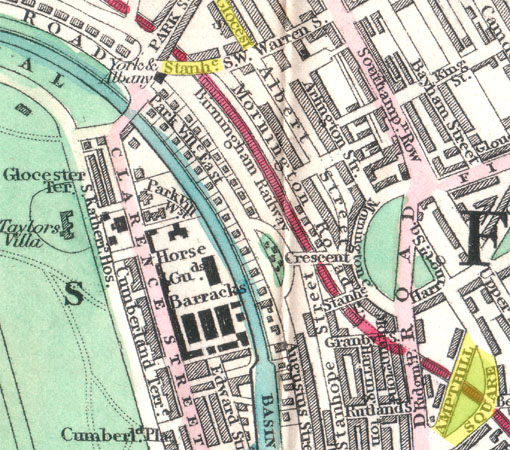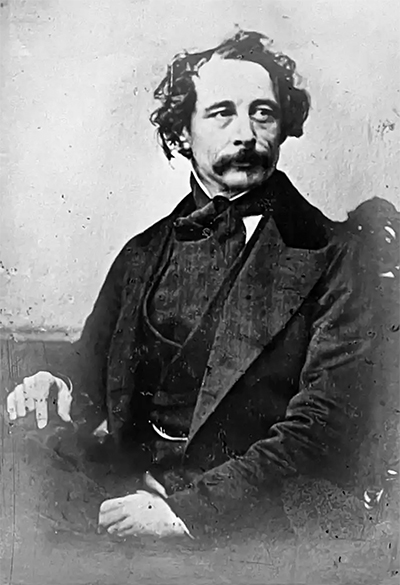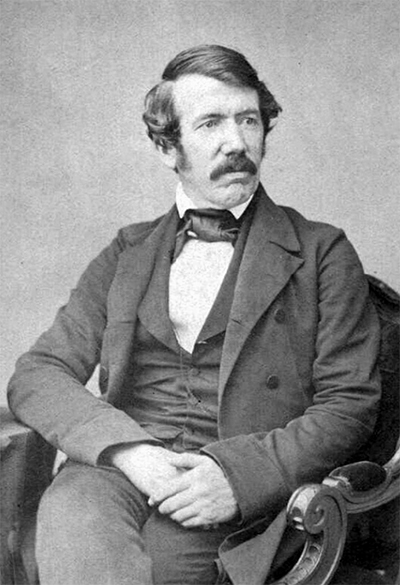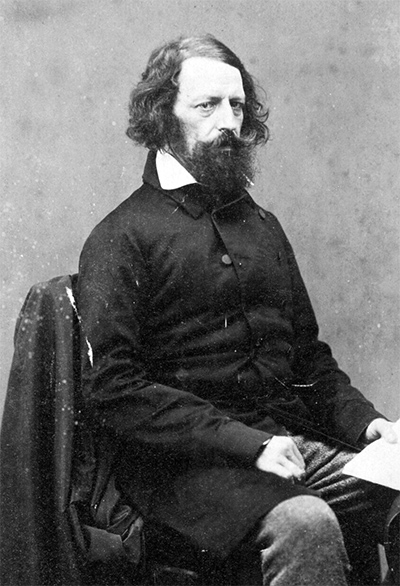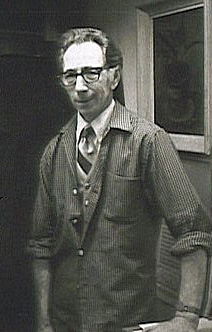Stream 1 - Introduction
b: Images and Medal of John Snow
Images of John Snow
1846 PAINTING
Painted by Thomas Jones Barker (1815-1882) in 1846. Dr. Snow was 33 years old and
general practitioner for the Barker family. The portrait was included by
Barker in an 1847 exhibition at the Royal Academy in London.
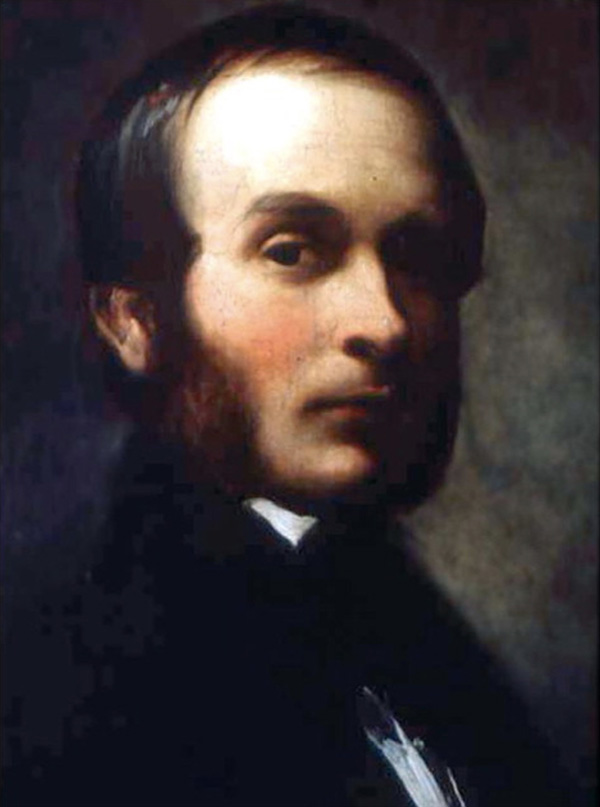
Barker's identity remained a mystery until 2001 when reported in Anaesthesia by Dr. David Zuck.
Source:John Snow, Portrait in Oil. Thomas Jones Barker, 1847.in Zuck D. Anaesthesia 56, 227-230, 2001.
Thomas J. Barker
Biography
Thomas Jones Barker was born in Bath, England in 1815, the eldest son of a prominent painter,Thomas Barker. At age 19 he went to Paris in 1834 and studied for several
years in the studio of Horace Vernet. During his time in Paris he painted
extensively for prominent families, and received many gold metals in regional
showings for his work. In 1845 he returned to England, settled in London, and became known as a
painter of portraits and military subjects. He was a frequent exhibitor at
the Royal Academy of Arts in London, and many of the most distinguished men of the times
sat for him. It is likely that Thomas Jones Barker became acquainted
with Charles Empson (John Snow's uncle)
during this time, since Empson was an art dealer in Bath and the Barker family
were all well-regarded artists, known as the "Barkers of
Bath."
On the outbreak of the Franco-German war in 1870, Barker became prominent as a painter
of military works. He died in London on March 27, 1882.
Zuck's Detective Work
How did David Zuck come to identify Thomas Barker as the unknown artist of the John
Snow portrait? The answer lies in good historical detective work. Zuck was reviewing the published Anesthesiology Case Books of Dr. John
Snow. He was interested in Snow's medical practice, other than anesthesiology, and plotted Snow's non-anesthetic house visits on a map of
London. Included among the addresses were the family homes of Thomas Jones Barker and his family: 1) 37 Gloucester Road, 2) 101 Stanhope Street, and 3) 40 Ampthill
Square.The streets (in yellow) are shown in Cruchley's 1846 map of London. The homes are located by the northeastern edge of Regent's
Park.
Zuck reasoned that Dr. John Snow was the general practitioner for the Barker family, counting nearly 100 visits to these three addresses in the historical Case Books. It appears that Thomas Jones Barker painted Dr. Snow in 1846, possibly in appreciation for his medical assistance.
Exhibition in the Royal Academy of Arts
The Royal Academy was founded in 1768. In John Snow's era, an annual
exhibition was held each year in May, and artists were limited to no more than
eight works. Zuck's final proof that Barker painted the Snow portrait
appeared in a publication of The Royal Academy Exhibitors. In 1847, Thomas Jones Barker exhibited three works, one of which was
entry 601 listed as "Dr. Snow." It seems that this was the mysterious 1846 portrait of Dr.John Snow.
The
momentary fame from The Royal Academy showing likely helped Snow's career, bringing him to the public's attention
a mere three years after he obtained his MD degree from the University of London.
SOURCES:
Cruchley, GF. Cruchley's New Plan of London improved to 1846, Cruchley Map Seller and Publisher, 1846.
Ellis RH ed. The Case Books of Dr. John Snow, London, 1994.
Stephen L, Lee S (ed). The Dictionary of National Biography, Vol. 1, 1921-22.
Zuck D. Anaesthesia 56, 227-230, 2001.
1857 IMAGE
Having ascended to great prominence in anesthesiology following administration of chloroform to Queen Victoria during the earlier birth of Prince Leopold in 1853 and again in March of 1857 during the delivery of Princess Beatrice, John Snow likely decided to commission another portrait, but this time employing the young and rapidly evolving field of photography. The product of that commission became the most common image of Dr. Snow. later appearing in textbooks or references in epidemiology and anesthesiology, as shown below.
What Snow had not realized is that the clear view of photography would enable an investigator in 2009 to detect the swelling of his fingers, known to be associated with chronic renal failure. Following Snow's death on June 16, 1858, the autopsy cited the cause as a stroke, with chronic renal failure listed as a contributing factor.
Snow's probable 1857 image (some estimate the date as 1856) was photographed by a supposed anonymous person likely during mid-1857 when Dr. Snow was 44 years old, about a year before his untimely death. In further review of similar style portrait photographers in Snow's neighborhood, the most likely person was famed photographer John Jabez Edwin Mayall (1813–1901). His studio was at 224 Regent Street, at the corner of Argyll Place (red dot), not far from Snow's home at 18 Sackville Street (blue dot). Mayall also made portraits of author Charles Dickens in 1853 and 1855, and of the Royal family in 1860. Snow probably purchased his portrait directly from Mayall's studio but did not authorize Mayall's resale, as was custom with more famous people. Upon Snow's death, his photo was passed on, along with other papers, to his friend Benjamin Ward Richardson who's subsequent publications made famous the "anonymous"photo, but without a proven date.
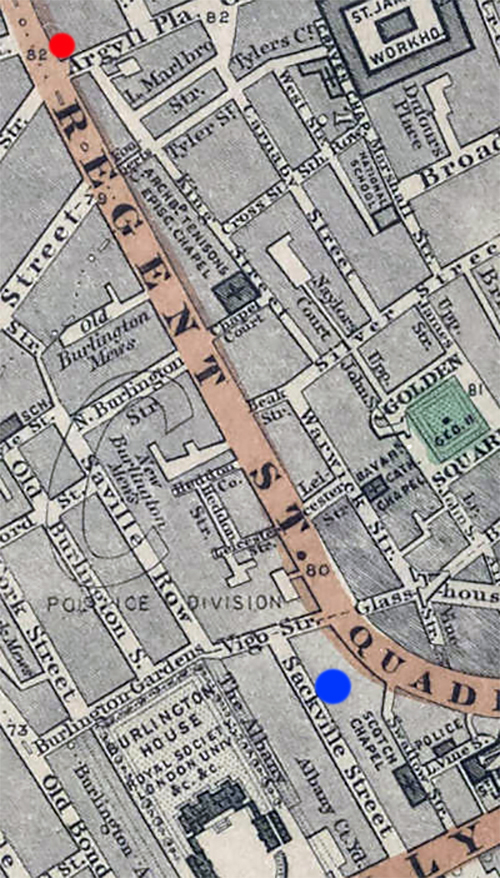
SOURCES: Stanford's library map of London and its suburbs, London England, 15 February 1862 with additions to 1865.
Mawson, A.R. The hands of John Snow: clue to his untimely death? Journal of Epidemiology and Community Health 63(6), 497-499, 2009.
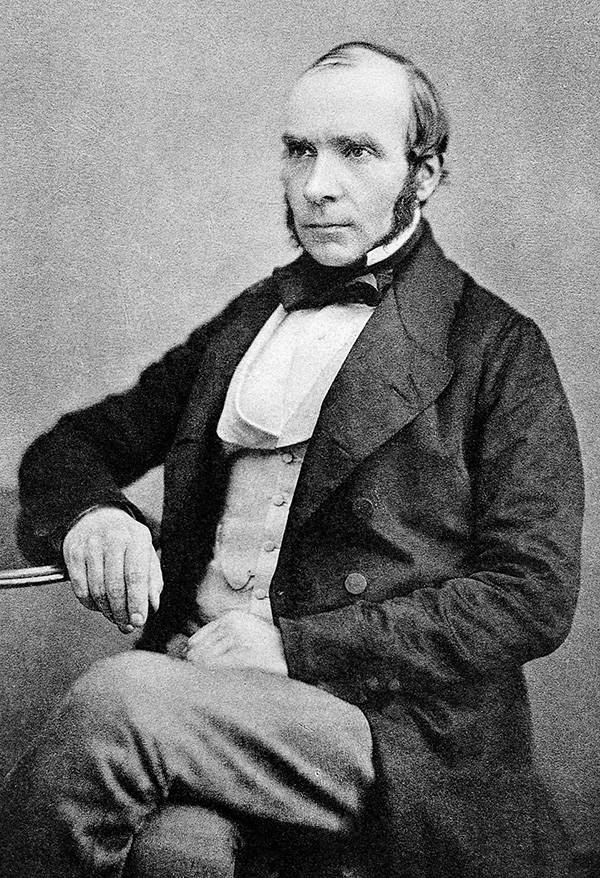
John Snow, Photograph, 1857. Wellcome Historical Medical Museum and Library, London in Gordis L. Epidemiology, WB Saunders, Philadelphia, 1996.
Was John Jabez Edwin Mayall the anonymous photographer? Three other portraits taken by Mayall during the same years closely resembled the formal attire, setting and background of the John Snow image, including famed author Charles Dickens (1855) at left, Scottish physician and explorer David Livingstone (1857) in center, and Poet Lauriet of England Alfred Lord Tennyson (1861) at right.
Medal of John Snow
In 1971, over a century after Dr. John Snow's death, Abram Belskie, the famed medallic artist and sculpture, created a bronze medal of John Snow.
FRONT
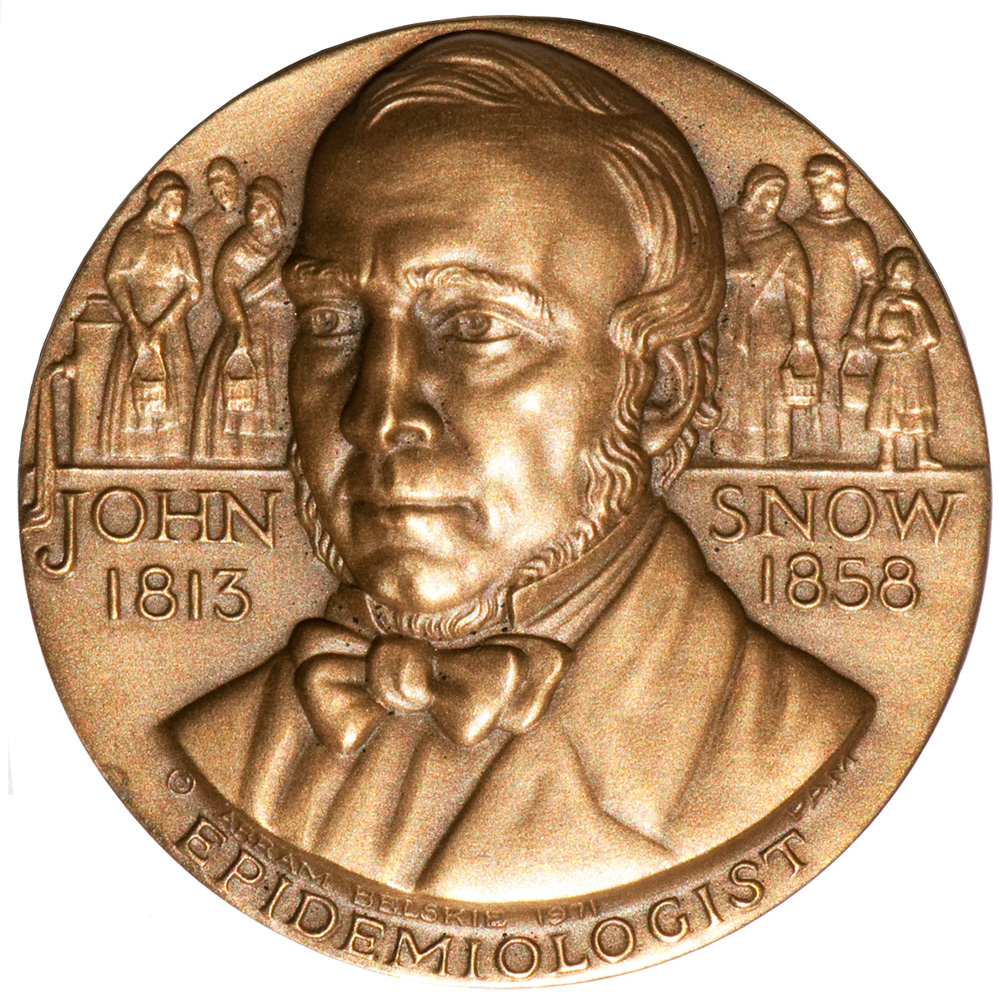
The medal shows the birth (1813) and death (1858) years of Dr. John Snow, and people getting cholera contaminated water from a neighborhood pump (at top left) in London, England. As shown above the word "Epidemiologist," the medal was created by Abram Belskie in 1971 as part of his Great Men of Medicine Series . It was commissioned of Belskie by PAM, an abbreviation of the commercial company, Presidential Art Medals, Inc. of Englewood, Ohio. This bronze medal bestows honor only on Dr. John Snow, and not the recipient, and is typically sought for its historical and medalic art quality by collectors and museums. The medal weighs 61 grams, and is about 1.75 inches in diameter and 1/4 inch at its thickest section.
BACK
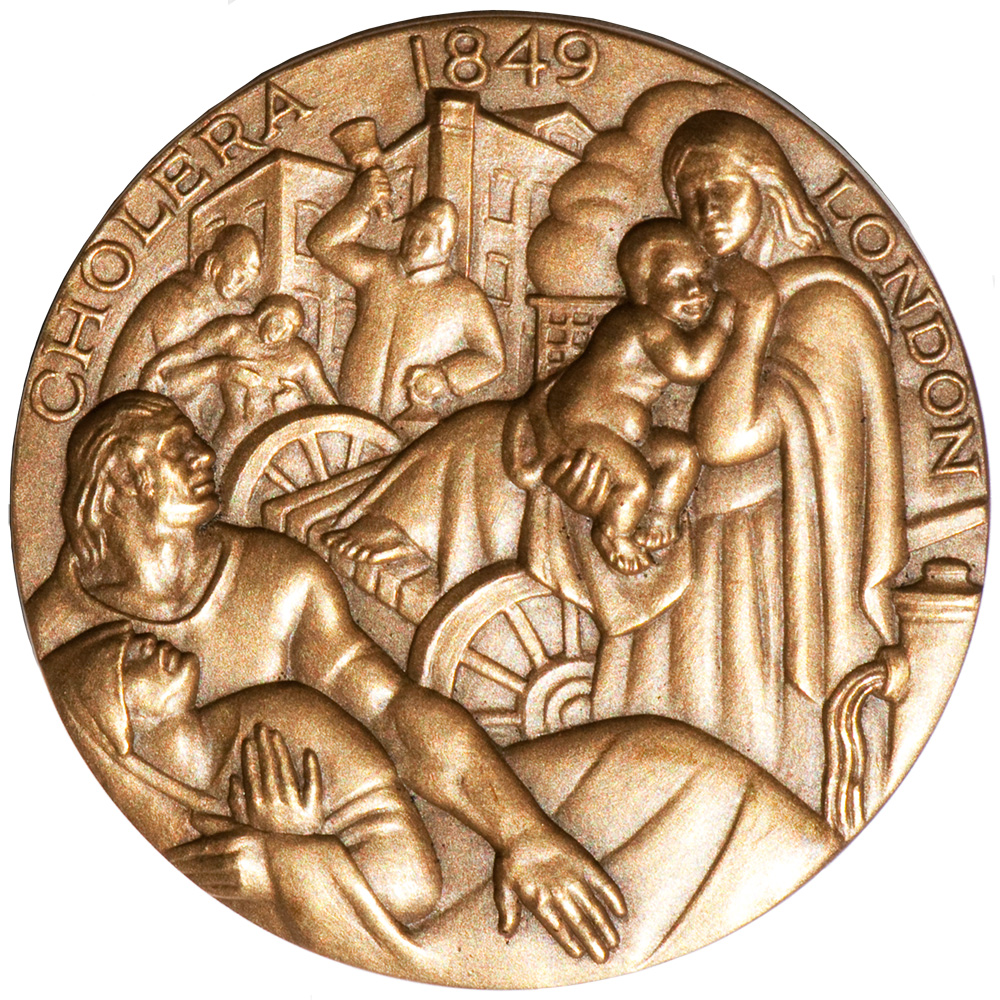
The back of the medal focuses on 1849, the second of two years (1848-49) when cholera returned to London, following the earlier epidemic of 1831-1832. Persons in industrial London (symbolized by billowing smoke coming from a factory) became sick from consuming contaminated water, illustrated by the water flowing from the pump at right. A hand bell is being knelled at the top of the medal, following a cholera death. On the right side, a mother holds her infant, worrying that cholera will strike, while watching a man (perhaps her husband) cradle a sick or dead person.
While Belskie's medal does well in depicting the horrors of cholera, his intent was to honor Dr. John Snow. To this end, a more appropriate year for the top of the medal would have been 1854, when cholera returned a third time to London. It was in 1854 when John Snow conducted two epidemiological studies, both now considered historic classics in the field of epidemiology. The first was the "Grand Experiment," in which Snow analyzed data on the distribution of household water in the same neighborhoods coming from two water companies; one company had moved up the River Thames to a fresh water site while the other remained in a cholera polluted site of the river. The second was the Broad Street Pump Outbreak, where John Snow had investigated an explosive cholera outbreak in the Soho neighborhood of London and found that the Broad Street pump was a factor common to most cases. He persuaded the parish authorities to remove the handle of the pump and the cholera outbreak subsided.
Along with John Snow (1813-1858) in the Belskie series were eight other prominent medical scientists who greatly impacted the time of Snow and beyond, attesting to his considerable reputation as a member of this gifted group. Included in the bronze medal series during Snow's lifetime were: Robert James Graves (1796-1854), Ignaz Philipp Semmelweis (1818-1865), Pierre Charles Alexandre Louis (1787-1872), Dominique Jean Larrey (1766-1842), Claude Bernard (1813-1878), Thomas Addison (1793-1860), J. Marion Sims (1813-1883), and and Richard Bright (1789-1858).
Abram Belskie
Belskie was a British-born sculptor, starting life In London, England on March 24, 1907 and ending on November 7, 1988 in Closter, New Jersey, USA, now the site of the Belskie Museum of Art and Science. He was 64 years when he finished the John Snow bronze medal.
While born in London, Belskie was raised in Glasgow, Scotland, and at age 15 became an apprentice to a local painter and started classes at the Glasgow School of Art. Four years later at age 19 he graduated from the School of Art, having received a prize that allowed him to study art on the European continent. In November, 1929, twenty-two year old Belskie packed his belongs and left for New York City, where he found a studio job with London-born sculptor John Gregory. During the following three years, Belskie helped Gregory in the fabrication of bas-reliefs for the façade of the Folger Shakespeare Library in Washington, DC. Before the work was finished, Belskie at age 24 moved to Closter, New Jersey, where he remained until his death in 1988. In Closter, at first he worked at the studio of the master-carver Robert Alexander Baillie and then later became an independent artist.
The seeds for the medal series were planted in 1938 when the prominent American scultor and author Malvina Hoffman introduced Belskie to the eminent physician Dr. Robert Latou Dickinson. Dr. Dickinson was an obstetrician and gynecologist, and significant figure in American sex research. He pioneered the creation of medical models for teaching students anatomy, procedures and diagnoses. Dickinson knew that the effectiveness of such models relied on keen eye and hands of a scupture, rather than a physician, and upon meeting Belskie, a bond was created. A year later in 1939, the first fruits of their collaboration were displayed in an exhibit on Maternal Health at the New York World's Fair of 1939. Over the next 11 years until Dickinson's death in 1950, the two collaborators created thousands of medical models.
Great Men of Medicine Series
Belskie began his career as a medallic artist in 1952, two years following the death of friend and mentor, Dr. Dickinson. For years he created medallions, many of them medical in nature, including the group of ten medical scientists commissioned for commercial sale by the Presidential Art Medals, Inc. of Englewood, Ohio and struck with the Medalilic Art Company, then in New York (Great Men of Medicine Series). While it is not clear who suggested to Belskie the group of 10 medical scientists for the bronze medals (as well as an identical silver series) which he created during the late 1960s and early 1970s, likely the seed was planted by Dr. Robert Latou Dickinson.
Besides Dickinson, Belskie worked with other physicians. Though he was not a doctor, he became a full faculty member of the New York Medical College, where he taught several generations of physicians. Abram Belskie was also the first forensic artist, pioneering the field of reconstructing features postmortem.
Sources:
Anonymous. Abram Belskie, Wikipedia, 2011.
Anonymous. Abram Belskie, Belskie Museum of Art and Science, Coster, New Jersey, USA, 2011.

